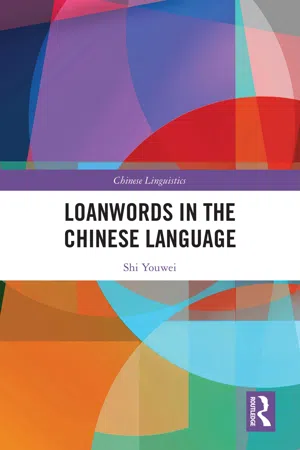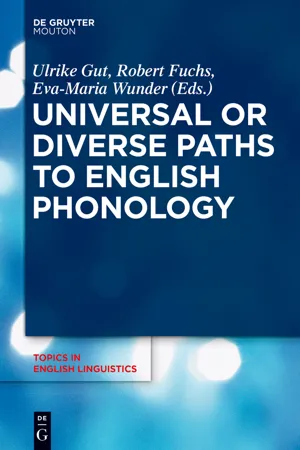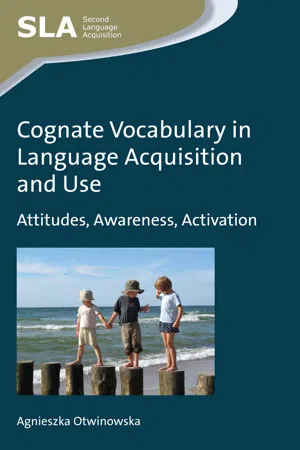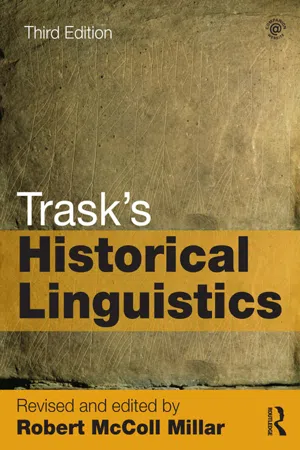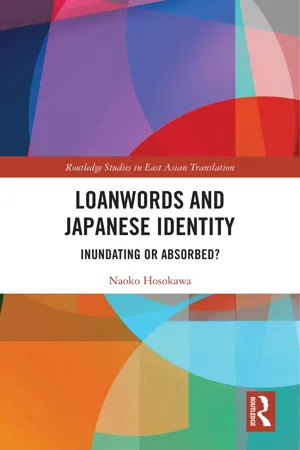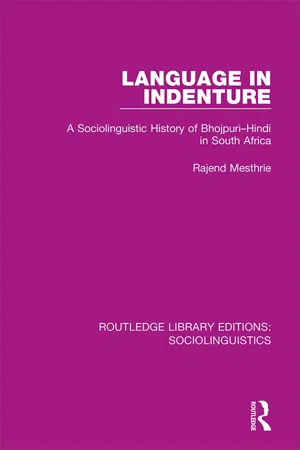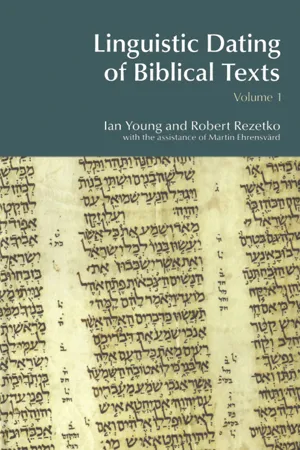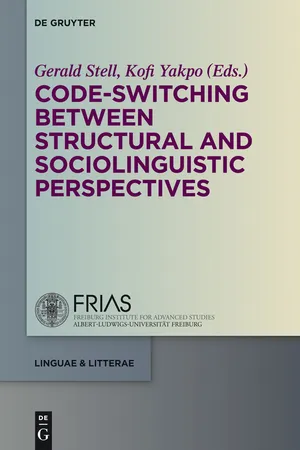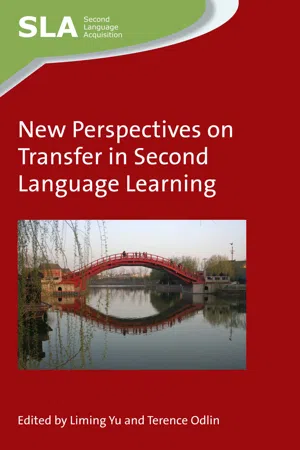Languages & Linguistics
Loanwords
Loanwords are words adopted from one language and incorporated into another. They often reflect cultural exchanges and historical influences between different societies. Loanwords can enrich a language's vocabulary and provide insight into the interactions and connections between different linguistic communities.
Written by Perlego with AI-assistance
Related key terms
Related key terms
1 of 4
Related key terms
1 of 3
10 Key excerpts on "Loanwords"
- eBook - ePub
- Shi Youwei(Author)
- 2020(Publication Date)
- Routledge(Publisher)
6 An overview of Chinese loanword studies6.1 Areas of loanword studies
The linguistic, cultural, and social functions intrinsic to any lexicon mean that the loanword, as part and parcel of it, is the semiotic integration of language, culture, and society. From that, we can explore the following five areas, which each include further concentrations for loanword studies.With loanword studies a part of language research, we may have an investigation of:- The etymology of the loanword to examine which language it comes from and the lexical and semantic origin of the word
- Lexical identity, such as criteria to be used to determine the identity, qualifications, tier, and type of the loanword, and to prevent any false or pseudo-words from entering into the category or to remove such words which have already entered
- Lexical composition to analyze the various representation forms and modes of composition so as to help determine the type and stratum of the loanword
- Semantic evolution to ascertain the initial meaning of the word at the time of borrowing and how it has evolved into the present meaning
- Written representation to analyze how the loanword is presented in writing and how it affects the borrowing language and its loanword assimilation in order to work out a viable scheme for written representation
- Phonetic representation: how the loanword is actually pronounced in real life and how it phonetically varies between different geographic regions and demographic communities
- Linguistic impact: how the loanword influences the borrowing language in terms of word formation, phonetics, syntax, pragmatics, and rhetoric, and how it affects the lexicon of the language as a whole
- 8 Cultural exchange: the background of the cultural exchange behind the lexical borrowing, the trajectory of the borrowing, the cause and effect, the driving forces or the potential resistance, and its resolution in such exchanges
- eBook - ePub
- Ulrike Gut, Robert Fuchs, Eva-Maria Wunder, Ulrike Gut, Robert Fuchs, Eva-Maria Wunder(Authors)
- 2015(Publication Date)
- De Gruyter Mouton(Publisher)
2. Unlimited/infinite set of vocabulary. (Hence, called Loanwords and not loan- language) (Hence, called second language and not second word/vocabulary) 3. Only “words” from another language are adopted. So, one may not be aware of the syntax or the morphology of the L2. Use of words of the L2 in sentences of the L1. So, dictated by faithfulness to the morphosyntax and phonology of the L1. 3. Acquisition of an L2/L3 involves learning not just words, but the phonology, the syntax, the semantics and the morphology of the L2/L3 and involves the use of “full sentences” in the second language. So, dictated by faithfulness to the morphosyntax and phonology of the L2/L3. 4. Product of the historical/diachronic development of a language in a language contact situation – phylogenesis. 4. Product of the development of a language in an individual -ontogenesis.2 Statement of the problem
With regard to English Loanwords in Bangla, we find that the phonological changes that they undergo are different from the changes we perceive in some Sanskrit or Arabic loans. We note that an important factor that has been ignored in studies on loanword adaptation is the following:The Many-to-One Problem:Most studies focus on one source language and one target language, e.g. English Loanwords in Korean or Japanese, French loans in Arabic and so on. There are no studies of Loanwords in multilingual contexts where there may be two or more source languages. Different repair strategies may be perceived in Loanwords adopted from different languages at different times. For example, the borrowing language may use the repair strategy of deletion when incorporating Loanwords from Language A at one point of time, whereas it may use epenthesis for Language B at another point of time, for the common problem of avoidance of a complex coda or onset. For example, an English word like cream could be incorporated as /kəri:m/ by epenthesis of a vowel to avoid the complex sequence /kr/ in the onset of the syllable, whereas a Hindi word with a complex onset like / / may be pronounced as / - eBook - ePub
Cognate Vocabulary in Language Acquisition and Use
Attitudes, Awareness, Activation
- Agnieszka Otwinowska(Author)
- 2015(Publication Date)
- Multilingual Matters(Publisher)
Borrowing can be understood as ‘the incorporation of foreign features into the group’s native language by speakers of that language: the native language is maintained but is changed by the addition of the incorporated features’ (Thomason & Kaufman, 1988: 37). In common understanding borrowing is limited to vocabulary. According to a recent definition:items/structures are copied from language X to language Y, but without speakers of Y shifting to X. In this simple form borrowing is characteristic of ‘cultural’ contact, e.g. Latin and English in the history of the latter, or English and other European languages today. Such borrowings are almost exclusively confined to words and phrases. (Hickey, 2010: 18)However, restricting borrowing to words is insufficient, since the process can involve much more than simply adopting foreign vocabulary items. As was widely discussed by the classics of language contact literature in the 1950s and 1960s (e.g. Haugen, 1950; Hockett, 1958; Weinreich, 1953), there is a much broader range of what can be borrowed between languages. In Haugen’s (1950: 212) definition of the process, it is language ‘patterns’ rather than vocabulary items: ‘borrowing is then the attempted reproduction in one language of patterns previously found in another.’ Clearly, this definition goes beyond the lexicon because the patterns to be reproduced do not have to be of a lexical kind. The new element, or pattern first penetrates from one language to another, then its use spreads till it is assimilated by the second language community and stops being perceived as foreign.Languages in contact are variously referred to in literature on the subject, as the ‘source’ or the ‘lending’ language and the ‘recipient’ or ‘borrowing’ language (e.g. Haugen, 1950; Thomason & Kaufman, 1988). Some other researchers prefer calling them the ‘donor’ language and the ‘recipient’ language (e.g. Winford, 2003), or the ‘source’ language and the ‘receiving’ language (Thomason, 2010). Of interest is also the very meaning of the term ‘borrowing,’ the inappropriateness of which was first pointed out by Haugen (1950: 211) ‘The metaphor implied is certainly absurd, since the borrowing takes place without the lender’s consent or even awareness, and the borrower is under no obligation to repay the loan.’ The inadequacy of term is also often noted in recent sources: - eBook - ePub
- Robert McColl Millar, R L Trask(Authors)
- 2015(Publication Date)
- Routledge(Publisher)
There are, in fact, many different ways of acquiring new words, some of them very common, others rather unusual. In this chapter we will review these sources of new words, beginning with the simplest and most obvious source of all.2.1 BorrowingAt present there are some 6,000 different languages spoken on our planet; every one of these languages has a vocabulary containing many thousands of words. Moreover, speakers of every one of these languages are in contact with neighbours who speak different languages this is true today even for people living on remote Pacific islands on which they had previously been isolated for centuries. Consequently, everybody is in a position to learn some of the words used by their neighbours, and very frequently people take a liking to some of their neighbours’ words and take those words over into their own language. So, for example, the word glasnost was taken into English from Russian in the mid-1980s to denote the new political and social climate initiated by President Gorbachev in the former USSR, and, by extension, greater openness in any organization, just as the Russians had earlier taken the word vokzal from English to denote a mainline railway station (at the time, Vauxhall Station in London was a particularly important station).This process is somewhat curiously called borrowing – ‘curiously’, because, of course, the lending language does not lose the use of the word, nor does the borrowing language intend to give it back. A better term might be ‘copying’, but ‘borrowing’ has long been established in this sense. Words that are borrowed are called loan words.Such borrowing is one of the most frequent ways of acquiring new words, and speakers of all languages do it. English-speakers have long been globally among the most enthusiastic borrowers of other people’s words and many, many thousands of English words have been acquired in just this way. We get kayak from an Eskimo language, whisky from Scottish Gaelic, ukulele from Hawaiian, yoghurt from Turkish, mayonnaise from French, algebra from Arabic, sherry from Spanish, ski from Norwegian, waltz from German and kangaroo - eBook - ePub
Loanwords and Japanese Identity
Inundating or Absorbed?
- Naoko Hosokawa(Author)
- 2023(Publication Date)
- Routledge(Publisher)
5 What Kind of Loanwords?
DOI: 10.4324/9781003197522-55.1 Loanwords as ‘Outside Within’
The textual analysis in Chapter 4 revealed that Loanwords (gairaigo) are often treated as being independent of the Japanese language (nihongo). The two concepts are contrasted through various sets of opposing qualities, such as ‘difficult’ and ‘easy’, ‘unfamiliar’ and ‘familiar’, and ‘horizontal’ and ‘vertical’, thus creating a perceptual dichotomy. Lexically speaking, Loanwords constitute one of the three main vocabulary groups in the Japanese language and therefore should be contrasted to the key remaining vocabulary types: native Japanese words (wago) and Sino-Japanese words (kango). However, in popular Japanese discourse, the concept of the loanword is often contrasted with the Japanese language as a whole. In almost all kinds of narratives used in the loanword debate, Loanwords are referred to as ‘foreign language’. At the same time, the Japanese language is typically referred to as nihongo not kokugo – the term nihongo being a means to compare the Japanese language with other languages, or to view it from the perspective of speakers of other languages. In this much, when Loanwords are discussed, the Japanese language is described as nihongo, even when there is no explicit reference to any specific foreign language. This suggests that Loanwords are perceived as part of a broad category of ‘foreign language’. It is a result of a socio-cognitive process in which Loanwords are categorised as foreign, and wago and kango as Japanese.Categorisation is an essential process in human cognition. Fowler (1986 : 16) has rightly argued that “[w]e understand the multitude of things and events we encounter in our daily lives by seeing them as instances of types or categories”. Fowler offers the examples of the categories of ‘table’, ‘weed’ or ‘pet’, and explains that “you can place a book or a cup on a table whether it has four legs or five or one; a weed should be torn up from the garden even if it sports an attractive flower; a pet may be admitted to the sitting room even if it is a cobra” (ibid.). Thus, classifying a certain thing into a category also means focusing on certain of its characteristics while occluding others. This view is supported by Lakoff and Johnson (1981: 123) when they state, “categorisation is a natural way of identifying a kind of object or experience by highlighting certain properties, downplaying others, and hiding still others”. Therefore, in social interaction, one subject matter can be classified into differing categories according to one’s interpretation since categorisation is “subject to negotiation and revision” (Fowler 1986 : 18). Yet, those categories themselves, according to Fowler, are often taken for granted and rarely examined (ibid.: 31). Similarly, Conboy (2007 - eBook - ePub
Language in Indenture
A Sociolinguistic History of Bhojpuri-Hindi in South Africa
- Rajend Mesthrie(Author)
- 2018(Publication Date)
- Routledge(Publisher)
To continue in this way for other semantic fields like ornaments, parts of the house, kinds of food, wild animals, birds, etc. would be repetitive. The loss of a great deal of native vocabulary, though symptomatic of a language in decline, need not necessarily signal a traumatic end in sight;indeed much of the vocabulary lost was something in the nature of excess baggage in the new land, where a new technical vocabulary had to be adopted, in the form of Eng Loanwords adapted to the B pattern. The history of Eng shows how a language may rely heavily on a foreign source (Norman French in the eleventh and twelfth centuries) for new terminology, or new words which merely replace native items, and still thrive. If we are to specify reasons for the obsolescence of SB we must look to factors involving the numbers of speakers, their distribution, economic position, and attitude to the language, rather than shortcomings in the language itself – which had shown that it had the capacity to adapt and survive, given favourable external circumstances.4.6 MORPHO-SYNTACTIC CHANGEIn this section I examine the morphological treatment of Loanwords, as well as the major morpho-syntactic innovations in SB.4.6.1 The morphology of borrowed wordsLoanwords used by older, non-Eng-speaking individuals show a lack of knowledge of the grammatical and lexical system of the source language. Such speakers borrowed phrases and compounds, with out analysing (or being able to analyse) them into their sub-components, for example, ceikhan (a noun based on the Eng phrase ‘shake hands’). Thesentence Ose ceikhen karlak, literally translated is ‘With him he shake-hand did’ (‘he shook hands with him’). Similarly we can cite rauner aun from ‘round and round‘; raithen ‘ right hand‘; lefthen ‘ left hand‘;ā fkaran’ half-a-crown‘; sotpans’ short pants‘; stāfnes’ staff nurse‘; and laswān’ - eBook - ePub
- Ian Young, Robert Rezetko(Authors)
- 2016(Publication Date)
- Routledge(Publisher)
How are Persian Loanwords Recognised? We must first state the obvious: Loanwords in Hebrew do not bear a tag stating ‘borrowed from Akkadian’ or ‘Persian loanword’. Any word of the Hebrew Bible is potentially (but generally unlikely to be) a loanword.Watson describes the process of discovering Loanwords as follows:Generally speaking, the drive to find Loanwords comes from the need to resolve philological problems. If no meaning or derivation can be found for a particular word in one Semitic language, then one has to turn to other Semitic languages. So, for Hebrew, the scholar turns to Arabic, Syriac or Aramaic and if necessary, to Akkadian, Phoenician or Ugaritic. If this yields no results, then the lexica of non-Semitic languages are searched: Hittite, Egyptian, Hurrian, Greek (Watson 2005: 192).As a glance at any discussion of Loanwords will show, scholars often disagree on the origin of various suggested Loanwords in the Hebrew Bible. The basis for this disagreement is different evaluations of how well the form and meaning of the suspected foreign word fit the attested form and meaning in the Hebrew Bible. That the identification of Loanwords is hypothetical is well stated by Mankowski: ‘These considerations serve to underline the fact that, for the languages in question, the identification of a loanword will almost always be conjectural: a series of ordered hypotheses about the history of the language contact situation, the diachronic phonological development of the donor and receptor languages, and the ad hoc progress of semantic continuity for the word in question’ (Mankowski 2000: 7; cf. 3–7).An additional, absolutely crucial factor, is a scholar’s judgment that a particular language could historically have been the source of the borrowing. It is a well-known phenomenon that all languages, even those completely unrelated to each other, share a number of words that are coincidentally similar in form and meaning. In the case where the meaning of a word in its biblical context is unsure, we could imagine that a number of similar-sounding non-Hebrew words could make passable sense in that context. But is it likely that a word found in an Australian aboriginal language could have been loaned into BH? At the very beginning of investigation of possible Loanwords in BH, it is common sense that there have to be some decisions made as to which languages to look to as possible sources of Loanwords in ancient Hebrew. - Gerald Stell, Kofi Yakpo, Gerald Stell, Kofi Yakpo(Authors)
- 2015(Publication Date)
- De Gruyter(Publisher)
synchronic distinction has been suggested between the two phenomena, requiring that any actual occurrence of a foreign word has to be classified as either a code-switching or a loanword (e.g. Sankoff, Poplack, & Vanniarajan 1990). The distinction was deemed necessary for two reasons. First, it had been clear since the early investigations of Haugen and Weinreich in the 1950’s that established Loanwords and less established words of foreign origin behaved somewhat differently: established loans tended to show more phonological integration into the host language. The second reason is more problematic because it has a theory-internal rather than an empirical basis. For most of the time between 1980 and 2000, the literature was focused on formulating syntactic constraints on the phenomenon, trying to identify at what points in a sentence a switch could be made without the sentence becoming ungrammatical. Promising constraints were formulated that, however, didn’t seem to hold for established Loanwords, nor for many other foreign-origin single words, which were less likely to be established as widely accepted Loanwords. The suggestion was that the constraints held for codeswitches, not for Loanwords, even if they were used only sporadically. Thus, it became imperative to identify Loanwords in a reliable way, but without the criterion of wide acceptance in the speech community. Furthermore, the criterion had to be independent from the way a word was used in a bilingual sentence, since otherwise the argumentation would be circular: the constraint would hold for codeswitches but not for Loanwords, and a loanword would be a word that violates the constraint. Hence, the search was on for criteria that would unambiguously assign foreign words to either of two classes: codeswitches or Loanwords.This search has proved elusive. The code-switching community remains divided, as none of the suggested criteria have met with general acceptance. The main advocate of the distinction has been Shana Poplack, who has amassed impressive quantitative data on other-language single-word items in a variety of language pairs (see Poplack & Dion 2012). The data generally support the generalization that single-word insertions show the same morphosyntactic behavior as native words, whether or not they enjoy widespread use in the community (if they don’t, they are called ‘nonce borrowings’ ). If the base language has variable marking for a particular category, for example marking only a subset of direct objects with accusative case, single-word inserted object nouns tend to be variably marked in the same way, answering to the same- Liming Yu, Terence Odlin(Authors)
- 2015(Publication Date)
- Multilingual Matters(Publisher)
On the contrary, it bespeaks a high degree of language awareness and a rather sophisticated use of such awareness. Nor is the basic fact of Loanwords – which are felt still to have a ‘foreign’ aura – a denial of boundaries between languages. Thus, the English word restaurant – imported from French – still has a French enough profile to have retained a French nasal vowel in its final syllable, and English learners of French are probably on the whole aware that they can use the word in question in French. However, it is worth noting that they may also try it out when attempting to communicate in other languages – German, Polish, Chinese, etc.; if they do so, they are undoubtedly deploying an L1-based communication strategy, or at least a strategy that draws on knowledge of both English and French. To return to the case of Japanese learners, they are no doubt cognizant of the English language origins of many of the English Loanwords they use in Japanese, on the basis of the phonological shapes of the words in question, on the basis of their written katakana forms, on the basis of having encountered their counterparts in English and/or on the basis of general knowledge. When they exploit their familiarity with such words in their use of English, therefore, they are not mixing or conflating languages, rather they are quite simply making very sensible use of their knowledge, or perhaps even only their suspicion, that Japanese borrowed the items in question from the language they are trying to get to grips with. Another language featuring large numbers of English Loanwords that has recently been investigated in an English language learning perspective is Korean. English language elements are widely and deeply embedded in Korean, and they have in many instances taken on a distinctly Korean flavor in terms of meaning and usage. There is indeed even a term, Konglish, for borrowed English expressions that have been thus Koreanized- eBook - ePub
- John A. Goldsmith, Jason Riggle, Alan C. L. Yu, John A. Goldsmith, Jason Riggle, Alan C. L. Yu(Authors)
- 2011(Publication Date)
- Wiley-Blackwell(Publisher)
There are also other considerations in the selection of consultants. There has to be a reasonable match between the consultants and the social and pragmatic domains in which the borrowings occur. For instance, many French Loanwords in English come from the realms of gastronomy, décor, fashion, aircraft technology, and so on. In order to know those words, one must have a certain life experience that is unusual in young adults (such as university students). For the assembly of the corpus of French words in English we therefore found it preferable to recruit more mature adults whose interests and life experience made it much more likely that they would know the target vocabulary. Recall that we elicit words via their meanings, fill-in-the-blanks, and so on, so a word must be part of the consultant’s lexicon in order for him or her to produce it. If one ignores this limitation and simply presents borrowings in written form, some consultants may try to be overly accommodating and guess at the pronunciation of words that they do not in fact know.However, not all consultants try to be accommodating. For some speakers more than others, and for some languages more than others, the concept of borrowing words from another language is a very delicate topic that arouses strong feelings and raises defenses. Poplack et al. (1988: 76) report that social class membership is predictive of borrowing rates, so if a consultant consciously or unconsciously knows this and resists the idea of being identified with that particular social group, he or she may resist the idea that he or she exhibits similar behavior. We have found that some speakers strongly reject the idea that they or their language use borrowed words, particularly if native terms exist for the same or similar concepts. Thus, even if speakers with negative attitudes to borrowing can be convinced to participate in this type of research, they may not provide representative information.In sum, gathering first-hand loanword data is fieldwork and one quickly discovers that not all native speakers make equally informative consultants for the purpose of loanword adaptation. For the building of a corpus, phonologists might find it preferable to focus on selecting a few consultants, who are not too fluent in the source language, but whose vocabularies are nonetheless likely to include a good proportion of the L2 words that have to be verified, and whose attitudes are neither too accommodating nor too normative.
Index pages curate the most relevant extracts from our library of academic textbooks. They’ve been created using an in-house natural language model (NLM), each adding context and meaning to key research topics.
Explore more topic indexes
Explore more topic indexes
1 of 6
Explore more topic indexes
1 of 4
